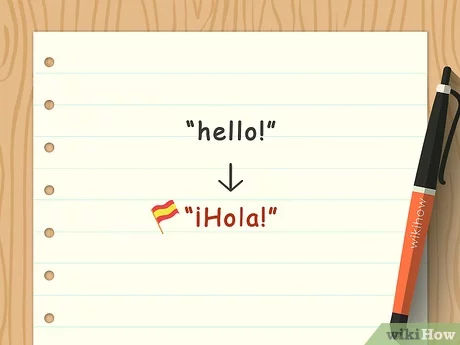¡Hola! Unveiling the Many Ways to Say Hello in Spanish
Have you ever been captivated by the vibrant culture of Spain or the rhythmic music of Latin America? Perhaps you’re planning a trip to a Spanish-speaking country or simply looking to expand your linguistic horizons. One of the most fundamental aspects of any language is learning how to greet others. This comprehensive guide dives into the delightful world of Spanish greetings, exploring various ways to say hello depending on the situation, time of day, and level of formality.
Saludos! Exploring the Art of Greeting in Spanish Culture
Spanish greetings are more than just words; they’re an expression of warmth, respect, and cultural nuances. Here’s a glimpse into the importance of greetings in Spanish culture:
-
Building Relationships: A friendly greeting is crucial for establishing rapport and creating a positive first impression.
-
Respect and Formality: Spanish culture emphasizes respect, and the choice of greeting reflects the level of formality in a situation.
-
The Power of Non-Verbal Cues: Body language and facial expressions often complement spoken greetings in Spanish communication.
By understanding these aspects, you can navigate greetings in Spanish with confidence and cultural sensitivity.
¡Hola! Unveiling the Universal Greeting
The most versatile and widely recognized way to say hello in Spanish is:
- Hola (pronounced oh-lah): This is a casual greeting that can be used in most everyday situations, similar to “hi” or “hello” in English. It’s suitable for friends, colleagues, or strangers in informal settings.
Hola! ¿Cómo estás? (pronounced oh-lah! KOH-moh es-tahs): This translates to “Hello! How are you?” and is a friendly way to initiate conversation after a greeting.
Buenos Días, Tardes, y Noches: Greeting According to the Time of Day
Spanish also offers greetings specific to different times of day, demonstrating a refined approach to communication:
-
Buenos días (pronounced boo-ehnos DEE-ahs): This means “Good morning” and is used from sunrise until around noon.
-
Buenas tardes (pronounced boo-ehnas TAR-des): This translates to “Good afternoon” and is appropriate from noon until sunset.
-
Buenas noches (pronounced boo-ehnas NO-ches): Meaning “Good evening” or “Good night,” this greeting is used from sunset onwards.
Important Note: While these greetings can be used literally, they are also common ways to say hello or goodbye depending on the time of day. For instance, “Buenas tardes” can be used as a general greeting in the afternoon, even if you’re not leaving.
Beyond Hola: Greetings for Different Levels of Formality
The beauty of the Spanish language lies in its ability to express varying degrees of formality through greetings:
-
Informal Greetings: These are used with friends, family, or close acquaintances. Examples include:
-
¡Hola! (Hola!): As mentioned earlier, this is the most common informal greeting.
-
¿Qué tal? (pronounced keh tahl): This casual greeting translates to “What’s up?” or “How are you?”
-
¡Ey! (pronounced ay!): This is a more youthful greeting similar to “Hey!” in English.
-
-
Formal Greetings: Used in professional settings, with strangers, or to show respect to elders. Examples include:
-
Buenos días/tardes/noches, señor/señora (pronounced boo-ehnos DEE-ahs/TAR-des/NO-ches, say-NOHR/seh-ニョーラ): This translates to “Good morning/afternoon/evening, sir/madam” and is a formal way to greet someone.
-
¡Hola! Encantado/a de conocerte (pronounced oh-lah! en-kan-tah-DOH/dah ko-no-THER-teh): This means “Hello! Delighted to meet you” and is suitable for formal introductions.
-
-
Very Formal Greetings: Used in very formal situations or with high-ranking officials. Examples include:
-
¡Muy buenos días/tardes/noches! (pronounced mooy boo-ehnos DEE-ahs/TAR-des/NO-ches): This emphasizes the well wishes with “Very good morning/afternoon/evening!”
-
¡Distinguido/a señor/señora! (pronounced dis-teen-GEE-doh/dah say-NOHR/seh-ニョーラ): This translates to “Distinguished sir/madam” and is used for utmost respect.
-
¡Adiós! Exploring Farewells in Spanish
While greetings initiate communication, farewells mark the end of an interaction. Here are some common ways to say goodbye in Spanish:
-
Adiós (pronounced ah-dyohs): This is a general goodbye that can be used in most situations, similar to “goodbye” in English.
-
Hasta luego (pronounced ah-stah loo-eh-go): This translates to “See you later” and is used for temporary goodbyes.
-
Hasta pronto (pronounced ah-stah prohn-toh): Similar to “Hasta luego,” this means “See you soon.”
-
Nos vemos (pronounced nohs veh-mohs): This translates to “We see each other” and implies you’ll meet again soon.
-
¡Chau! (pronounced chow): This is a more informal way of saying goodbye, similar to “bye” in English.
The choice of farewell depends on the context and your level of formality with the person.
Cultural Nuances: Embracing the Spirit of Spanish Greetings
Beyond the spoken word, appreciating cultural nuances enriches your understanding of Spanish greetings:
-
Body Language: A handshake is a common greeting gesture. A hug or kiss on the cheek might be appropriate with close friends or family.
-
Regional Variations: Some Spanish-speaking regions might have unique greetings or terms of endearment.
-
Non-verbal Cues: A smile and friendly eye contact are essential elements of a warm greeting.
By incorporating these aspects into your greetings, you demonstrate cultural sensitivity and make a positive impression.
¡Buen Camino! Embarking on Your Spanish Greeting Journey
Learning greetings in Spanish is like taking the first step on a fascinating linguistic adventure. Here are some tips to solidify your understanding:
-
Practice Makes Perfect: Rehearse greetings aloud and practice with native speakers.
-
Immerse Yourself: Listen to Spanish music, watch movies, or listen to podcasts to pick up natural greetings.
-
Don’t Be Afraid to Make Mistakes: Embrace mistakes as part of the learning process.
With dedication and a touch of cultural awareness, you’ll soon be greeting others in Spanish with confidence and flair.
Frequently Asked Questions (FAQ) About Greetings in Spanish
1. How do you respond to “Hola! ¿Cómo estás?”
You can respond with “Hola! ¿Y tú?” (pronounced oh-lah! ee too?), which means “Hello! And you?” or “Bien, gracias. ¿Y tú?” (pronounced byeen, grah-see-ahs. ee too?), meaning “Good, thank you. And you?”
2. What is a casual way to say hello to a group of people?
You can say “¡Hola a todos!” (pronounced oh-lah ah toh-dos!) which means “Hello everyone!” or “¡Hola a todas!” (pronounced oh-lah ah toh-dahs!) for an all-female group.
3. When would I use “Muy buenos días”?
“Muy buenos días” is appropriate for a very formal morning greeting or when emphasizing a pleasant good morning.
4. Is it okay to use “Adiós” for goodbye in any situation?
“Adiós” is generally a safe bet, but for temporary goodbyes or expressing a desire to see someone again soon, using “Hasta luego” or “Hasta pronto” might be more appropriate.
5. How can I learn more about regional variations in Spanish greetings?
Researching greetings specific to countries or regions you’re interested in can provide valuable insights. Listening to native speakers from different areas is another way to learn about regional variations.
By venturing into the world of Spanish greetings, you’re not just learning words; you’re unlocking a gateway to a rich culture and fostering meaningful connections with Spanish speakers around the world. So, ¡anímate (pronounced ah-nee-mah-teh; meaning “cheer up” or “go for it”) and embrace the joy of saying hello in Spanish!



